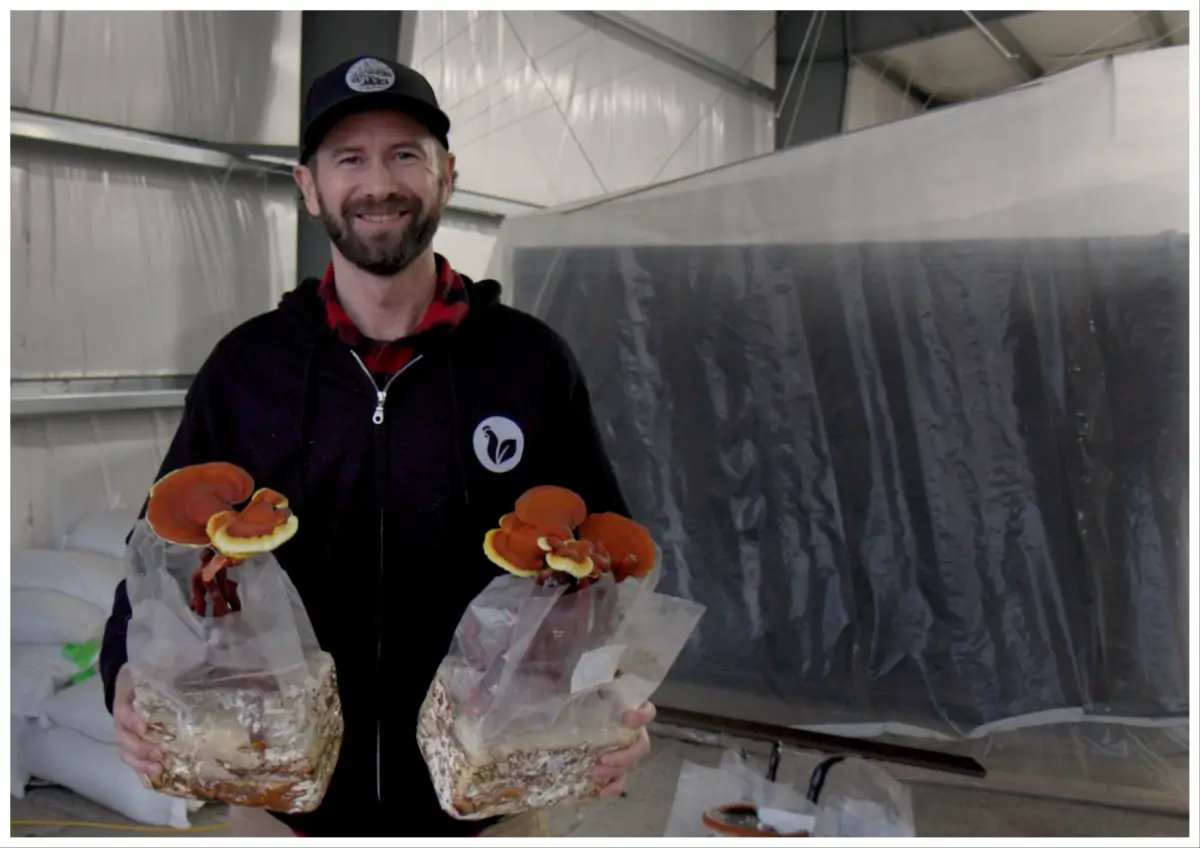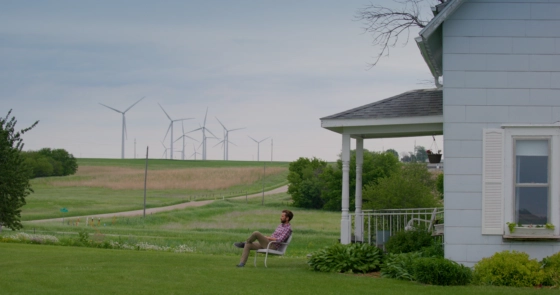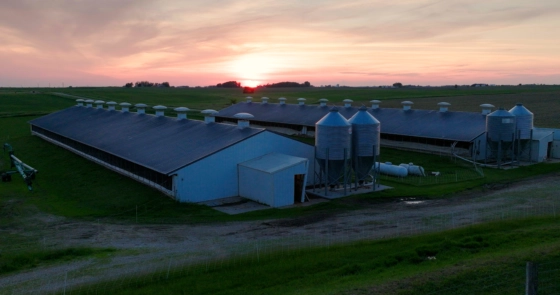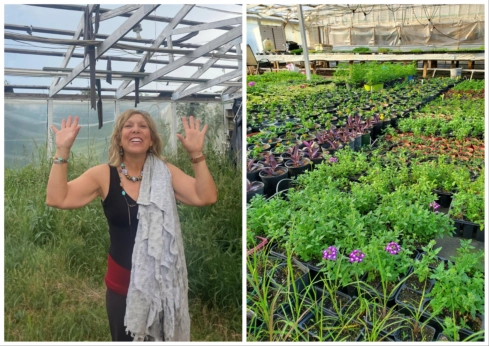Exiting the Factory Farm
This is part two in a series about the organizations that support producers transitioning out of factory farming and the farmers who make the leap.
Exiting the Factory Farm
This is part two in a series about the organizations that support producers transitioning out of factory farming and the farmers who make the leap.

Tanner Faaborg holding mushrooms that his family grew.by Transfarmation / Mercy For Animals
When Tanner Faaborg was growing up in Iowa, his family was fairly self-sufficient. But his parents knew they needed to add to their income if they wanted to one day send their kids to college and eventually retire.
“The path they were on, they wouldn’t be able to do that,” says Faaborg. “And that’s when Wendell Murphy started moving into Iowa.”
Murphy Family Farms (later bought by Smithfield Foods) helped out with the loan needed to get started. The idea was that after about 10 years, it would be completely paid off.
“It sounded like a pretty good deal,” says Faaborg. “And it turned out a little differently.”
To maintain their contract, the company required the Faaborgs to take on additional expenses, such as upgrades to their barns.
The Faaborgs farmed hogs for 30 years. When Tanner Faaborg came back to the farm as an adult, the family began thinking about ways to transition out of hog farming.
“We started to see all these family farms just disappearing,” he says. “And then it became this kind of existential thought process for us on, you know, what is the future of this farm?”
This question would end up guiding the Faaborgs’ transition out of hog farming and into a business model that Faaborg hopes will sustain his family and their community for years to come. For farmers like Faaborg and Paula and Dale Boles, whom you met in part one, this transition has proven to be difficult but not impossible.
“It doesn’t have to be a massive project,” says Faaborg. “You could start out with one small change.”

Risk tolerance
While many contract farmers find themselves in parallel positions—burdened with debt and lacking independence in making decisions on their farm—the path out of factory farming looks a little different for everyone. Animal Outlook, an organization that helps farmers transition out of contract farming, has a general blueprint it uses to help farms transition, but the actual steps vary, because each farmer has different circumstances. According to Angela de Freitas, director of farm transitions for Animal Outlook, these are conditions such as varying amounts of debt, regional positioning, knowledge of how to do other things, whether or not there is off-farm income, what kind of regional collaborators or partners exist and a farmer’s risk tolerance for trying something new. Animal Outlook works with poultry farmers who have had their contracts cut, which can happen at any time.
“They find themselves in a bit of a crisis, because it’s unexpected,” says De Freitas. “It’s not as if they have notice, they don’t have notice—it’s just like from one day to the next they don’t have a job, basically. Yet, they still have a tremendous debt load.”
One of the first things that some of the farmers she’s worked with have done is to start accumulating knowledge by going online and reading about others in similar positions. This early step helps them to realize that it’s not just them, says De Freitas. From there, farmers can begin reaching out to organizations such as Animal Outlook for support.
Animal Outlook is an animal advocacy organization, but De Freitas says any alternative to factory farming also has to be financially viable for producers. It’s important, she says, to see farmers as allies in building a different food system.
“We also approach it with the absolute understanding that if it doesn’t work for the farmer, if the transition cannot be financially successful and offer them a good quality of life, then it doesn’t work.”
The future of the farm
Finding others who share your vision for something different is an important early step. When Faaborg wanted to start changing the way his family farmed, he was met with some skepticism and felt overwhelmed with the process, he says, until he linked up with The Transfarmation Project. Tyler Whitley and the team there brought not only the can-do optimism for a big change like this but also came equipped with some of the technical knowledge and resources.
The Faaborgs began a pilot project to grow mushrooms, all while working with an outside team to retrofit the hog barn and convert it into a growing space. After eight months of learning the ropes, they now make and sell value-added products, such as tinctures and coffee blends. Finding the market for a new product was one of the most difficult parts, says Faaborg. But their website is now live for pre-orders under the name 1100 Farm. The “1100” is a nod to the fact that company barns were called “Murphy 1100 buildings,” in reference to the number of hogs that were housed in each barn. Faaborg included it in the name as a reminder of where they’ve been.
“It will always be a reminder of the change that’s possible and the change that happened on this farm,” says Faaborg.

Faaborg has also applied for funding from multiple USDA programs supporting projects geared toward things such as energy efficiency and oxbow wetland restoration. Faaborg’s goal is to showcase that it is possible to convert hog barns to do a different kind of farming, and in doing so create jobs and revitalize the local rural economy. A couple of years into this process, Faaborg now has an answer for the existential question he and his parents were asking at the beginning of the transition—what will be the future of this farm?
“I think this will be a family farm and stay in the family for generations to come. I think this will be a public space where people can come and tour the facilities,” he says. “I want people to be able to come out in the country and be in nature and actually see where their food comes from.”
The role of policy
One of the biggest obstacles that Kara Shannon, director of farm animal welfare policy for the ASPCA, has observed for farmers wanting to transition out of industrial animal agriculture and into specialty crops or something more humane is the lack of funding and resources available to overcome financial hurdles.
“The resources just aren’t there, which I think is particularly jarring for farmers who entered into the industrial model,” says Shannon, “because agricultural lenders are incredibly quick to give out enormous loans for farmers who want to build a CAFO [concentrated animal feeding operation]. And [they’re] not nearly as happy to loan to them for these types of projects.”
But that doesn’t mean there isn’t a way forward.
State and federal policy have a big role to play, says Shannon. At the federal level, the Farm Bill is a big piece of legislation that pours a lot of money into US agriculture, and, unfortunately, says Shannon, a lot of conservation funding through the Farm Bill goes to CAFOs.
“I think federal and state policy play a really huge role in shaping our farm system, which is evidenced by the decades of regulatory and policy choices that have gotten us to where we currently are with this consolidated industrial system,” says Shannon. “We really need policy now to support farmers who are trying to build both more humane but also more resilient regional food systems.”
Federal legislation moves slowly, but Shannon has observed that more and more states seem to be providing farmers with grants to diversify their operations. And it can make a big difference—Shannon points to Vermont, which recently launched a grant program for small farm diversification and transitions. An added bonus of this program is that, unlike some other grants such as the Value-Added Producer Grant Program, it doesn’t require matching funds from the producer, something that can be hard to pull off if you’re saddled with debt from contract farming.
“Vermont’s a big dairy state and a lot of the dairies are struggling,” says Shannon. “So, there’s been a lot of focus on helping them, and this grant program was one of the first major steps towards doing that.”
The ASPCA also helps fund some grants for farmers looking to make their operations more humane. Paula and Dale Boles, former Tyson poultry farmers, received one of these ASPCA-funded grants during their transition.
Thanks in part to Dale’s experience in construction, the Boles were able to adapt their poultry barns into greenhouses. During the transition, they have both held off-farm jobs, but at JB Farms, they grow things such as microgreens and vegetables. It’s important for farmers to experiment with different crops or ideas, says Paula Boles, to figure out what works for them. She has leaned into growing flowers under the name Grace Chapel Greenhouses. Two years ago, the Boles were able to pay off the lingering debt from their years in poultry farming.

“I walked into Carolina Farm Credit and handed them a check for $5,000 and paid off the loan from the business that we exited seven years prior,” says Boles. “But we live to tell about it.”
And their farm has found some new life as a community-centered space. They frequently have people coming out to the farm to visit or volunteer. The connection to the community has been rewarding for Boles—it’s the complete opposite of the Tyson tournament system, which pitted her farm against other farmers. Her goal is to one day be able to work in the greenhouse full-time.
“I have a vision, I have a long-term goal, something that I think will sustain us, something that will keep me healthy and keep me active,” says Boles. “You know, the whole thing that I thought was going to kill me I think is now going to sustain me.”
Catch the first part of this series here to read about what drove the Boles family to make their farming transition.
Follow us
This work is licensed under a Creative Commons Attribution-NoDerivatives 4.0 International License.
Want to republish a Modern Farmer story?
We are happy for Modern Farmer stories to be shared, and encourage you to republish our articles for your audience. When doing so, we ask that you follow these guidelines:
Please credit us and our writers
For the author byline, please use “Author Name, Modern Farmer.” At the top of our stories, if on the web, please include this text and link: “This story was originally published by Modern Farmer.”
Please make sure to include a link back to either our home page or the article URL.
At the bottom of the story, please include the following text:
“Modern Farmer is a nonprofit initiative dedicated to raising awareness and catalyzing action at the intersection of food, agriculture, and society. Read more at <link>Modern Farmer</link>.”
Use our widget
We’d like to be able to track our stories, so we ask that if you republish our content, you do so using our widget (located on the left hand side of the article). The HTML code has a built-in tracker that tells us the data and domain where the story was published, as well as view counts.
Check the image requirements
It’s your responsibility to confirm you're licensed to republish images in our articles. Some images, such as those from commercial providers, don't allow their images to be republished without permission or payment. Copyright terms are generally listed in the image caption and attribution. You are welcome to omit our images or substitute with your own. Charts and interactive graphics follow the same rules.
Don’t change too much. Or, ask us first.
Articles must be republished in their entirety. It’s okay to change references to time (“today” to “yesterday”) or location (“Iowa City, IA” to “here”). But please keep everything else the same.
If you feel strongly that a more material edit needs to be made, get in touch with us at [email protected]. We’re happy to discuss it with the original author, but we must have prior approval for changes before publication.
Special cases
Extracts. You may run the first few lines or paragraphs of the article and then say: “Read the full article at Modern Farmer” with a link back to the original article.
Quotes. You may quote authors provided you include a link back to the article URL.
Translations. These require writer approval. To inquire about translation of a Modern Farmer article, contact us at [email protected]
Signed consent / copyright release forms. These are not required, provided you are following these guidelines.
Print. Articles can be republished in print under these same rules, with the exception that you do not need to include the links.
Tag us
When sharing the story on social media, please tag us using the following: - Twitter (@ModFarm) - Facebook (@ModernFarmerMedia) - Instagram (@modfarm)
Use our content respectfully
Modern Farmer is a nonprofit and as such we share our content for free and in good faith in order to reach new audiences. Respectfully,
No selling ads against our stories. It’s okay to put our stories on pages with ads.
Don’t republish our material wholesale, or automatically; you need to select stories to be republished individually.
You have no rights to sell, license, syndicate, or otherwise represent yourself as the authorized owner of our material to any third parties. This means that you cannot actively publish or submit our work for syndication to third party platforms or apps like Apple News or Google News. We understand that publishers cannot fully control when certain third parties automatically summarize or crawl content from publishers’ own sites.
Keep in touch
We want to hear from you if you love Modern Farmer content, have a collaboration idea, or anything else to share. As a nonprofit outlet, we work in service of our community and are always open to comments, feedback, and ideas. Contact us at [email protected].by Lena Beck, Modern Farmer
May 7, 2024
Modern Farmer Weekly
Solutions Hub
Innovations, ideas and inspiration. Actionable solutions for a resilient food system.
ExploreExplore other topics
Share With Us
We want to hear from Modern Farmer readers who have thoughtful commentary, actionable solutions, or helpful ideas to share.
SubmitNecessary cookies are absolutely essential for the website to function properly. This category only includes cookies that ensures basic functionalities and security features of the website. These cookies do not store any personal information.
Any cookies that may not be particularly necessary for the website to function and are used specifically to collect user personal data via analytics, ads, other embedded contents are termed as non-necessary cookies.